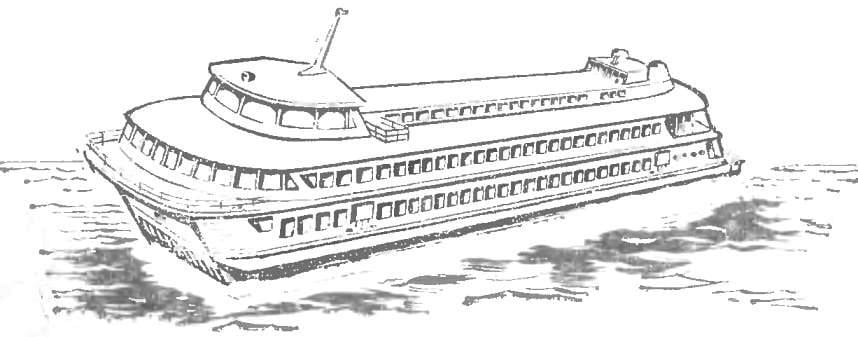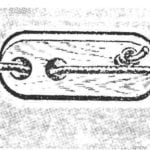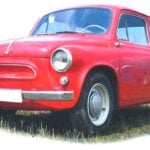 The day was cold, the autumn; the sea was rough. Gathered on the dock quietly talking, glancing at the captain of the ship.
The day was cold, the autumn; the sea was rough. Gathered on the dock quietly talking, glancing at the captain of the ship. — Surely in this weather come on!
— And how! — said the captain. — This day will help us to better identify the seaworthiness of the ship.
And that’s moved. Near the mooring steaks passengers saw some of the ships standing still.
— These, ‘ said the captain — also a hydrofoil, but the first generation. They are now in the sea it would be difficult.
The ship started slowly, not rising on the wings over the waves, as they say shipbuilders, in the “displacement mode.” It was quite rough, the ridges of water gets in the side, sharp nose, violently threw themselves on the glass Windows. But the speed began to grow, the body began to emerge from the water, and soon began to feel that the waves were somewhere at the bottom, and the ship moves along some smooth and calm surface. The contrast was striking.
So some time ago tested the country’s first gas-turbine ships sea passenger hydrofoils — “Typhoon” (Fig. 1). The model of the firstborn of the second generation hydrofoils, like many other novelties, which will be discussed, can be seen today at VDNKH.

Fig. 1. Maritime passenger gas-turbine ships “Typhoon” automatically controlled hydrofoil:
1 — passenger compartment, 2 — vestibule, 3 — pilothouse, 4 — promenade deck. 5 — aft wing, 6 — angled Z-shaped transmission full speed, 7 — 2 corner-shaped transmission slow speed, 8 — engine small progress, 9 — the main gas turbine engines, 10 diesel generators, 11 — bow wing, 12 — fuel tanks.
…In 1913 in Russia by water transported by 22.9% of the total number of goods and passengers — almost a quarter. By 1940 this figure dropped to 7.4%.
And in 1965 was altogether 5%. How to explain this!
The fact that in the beginning of the century average speeds by road, rail and water transport were equally small. But now the speed of rail transport increased to 200 km/h car almost close to it, is booming aviation with its fantastic speed. And water transport to the last time stood still. Displacement judging could not go beyond the range of 15-25 km/h, because at these speeds the large river passenger and cargo vessels began an intensive process of wave formation, which dampens the speed, and increase it becomes impossible. Where is the exit?
When the vessel is in the water creates a lifting force. It is proportional to the square of the speed. And if the latter will increase so much that the body will be able to get out of the water, the wave resistance will disappear and the court can move very quickly. To create additional lifting force need a special plane. So, according to valoyi aviation appeared underwater wings.
Twenty years ago, on the blue road of peace came the first hydrofoil (SEC). The novelty quickly became popular, and the SEC began to do in many industrialized countries. The first place among them was occupied by the Soviet Union. In the world there are more than thousands of the SEC, 80% of them in our country.
In 1957 was built the first passenger hydrofoil “Raketa”. It was equipped with engine of 825 HP and can reach speeds up to 70 km/h and could seat 66 passengers.
The next stage of development — the construction in 1960 of the “Meteor”. The engine power of 1800 HP, speed 65 km h, number of passengers — 128. “Raketa” and “meteor” became the core of the high-speed passenger fleet, quickly gained immense popularity.
The new hydrofoil was then gas-turbine ships “savages”. For the first time as the motors used not diesel engines, and turboprop aircraft installation.
And perhaps even the use of such expired aviation resource. Two engines with a capacity of 2,700 HP, powered by diesel fuel, allows to reach the speed of 95 km/h.
As a mover used the water cannon is connected via a claw coupling directly From the Engine. The hull of Swarup:I of aluminum-magnesium alloys.
For comfort “Petrel” significantly exceeds “Rocket” and “meteor”. The noise level in the passenger areas is two times lower. This is achieved by a series of design features. The engine room is located aft, separated by two bulkheads, between which are suspended sound absorbing material. And it is the inside lined with sound insulating pyramids.
But not only the reduction of the noise level determines the comfort of the Thunderbird, and the air conditioning in the cabin, with automatic temperature control. This ship is also has found application in river passenger fleet of our country.
And “Rocket” and “Meteor, and the “Petrel” of today belong to the first generation SPK. And the General trend of development traffic is such that hydrofoils are other qualities. First and foremost — seaworthiness.
SPK first generation was built for use on rivers and lakes. They were not designed to overcome the large wave. Meanwhile, life strongly requires the appearance of the SEC, and is able to make sea voyages. But it needs to solve a number of problems. Chief among them: the design of seaworthy outboard systems and small power plants of high power. All this is embodied in the new ship “Typhoon”.
When driving on a relatively calm surface water — river, lake — stabilization of the lifting force of SPK is automatically achieved. The smallest thickness of the water layer above the wing in the operating mode shall be prima “but R on the chord of the wing. If the water layer becomes thinner, the wing leaks air, the lifting force is reduced, the wing is immersed. When this lifting force is again increased, the wing rises.
This so-called malogruzovaja wings; they apply to the SEC first-generation. But for large wave these wings; I’m not. To stormy weather could not influence HB propulsion of the vessel in the open m of the sea, the wings should be completely immersed and deeply. But then no automatic stabilization of the lifting force; the position of the wings can be controlled by changing the angle of attack depending on the situation. And made the “Typhoon”. Electronic system of automatic stabilization and control movement is one of its principal novelties.
To the SEC first-generation main engines were small high-speed diesel engines, and the screws were inclined shafts. But limiting angle of this shaft is equal to only 12°. But if the ship rises so that this angle is not enough! To increase it is worsen the working conditions of the engines and propellers.
The way out — gas turbine and 2-shaped corner columns. This means that the horizontal shaft coming from the engine, transfers via a bevel gear torque to the vertical shaft, and that — again via the bevel gear on the screw shaft. This device is equipped with a “Typhoon”.
Fore and aft wings deep made from high strength stainless steel. Nasal wing takes about 77%, in the feed is about 23% of the total weight of the vessel. The bearing plane of the nose of the wing is separated from the main line of the body on 2.8 m. the Hull of riveted construction from high — strength aluminum-magnesium alloy. Management of all shipboard machinery and systems, including a system of automatic stabilization of movement, is done with remotes in the cockpit of the chassis.
Big waves in our time — not only seas, but rivers. In fact, take the Volga. Today is the cascade of reservoirs; waves there is, of course, not a river. A reservoir of the Siberian rivers. and the Dnieper!
SPK for the development of the second generation, which should replace and “Rocket” and “Meteor” came from the pioneers of the creation of the Navy hydrofoils in our country — Sormovo shipbuilders. And spring of this year the Commission of the Ministry of river fleet of the RSFSR adopted to operate a passenger hydrofoil “Voskhod-2” (Fig. 2).

Fig. 2. The hydrofoil “Voskhod-2”.
This vessel is of medium displacement, able to swim like rivers and large reservoirs. The new scheme of the wings allows him to overcome a wave height of 1.3 m. “Voskhod-2” walked the Black sea in a storm to 3 points and did not feel the shock wave. Compared to the first generation of SPK “Voskhod-2” looks even more rapid It is similar to both ship and plane.
But not only the wings can lift the body is capable of making and airbag. On these machines also work with domestic designers. Among the prototypes of the courts of the new type is “Sormovich” (Fig. 3), whose model is demonstrated with the Transport pavilion of the VDNKH of the USSR.

Fig. 3. The gas-turbine ships hovercraft “Sormovich”.
This machine, built by the factory “Red Sormovo”, is an amphibian. Air cushion is formed thanks to the powerful fan, which through the nozzles to blow air under the enclosure having a bottom edge, the flexible protection — the “skirt”. Engine room fan and propellers located aft, and the saloon in front. This reduces the noise level in the cabin to, in addition, to ensure good visibility.
Material of hull and superstructure — light alloys, United by welding and riveting. Fan, propellers and gearboxes is designed and manufactured specifically for the “Sormovich”. Main engine — aviation gas turbine, running on diesel fuel.
Tests showed that at full load the ship easily comes out on a cushion of air, quickly gaining speed to 100 km/h and at the speed of 50 km/h continuously, without jerking, to “sit” on the water. It is able to go where no other ship will not pass — go, as they say shipbuilders, outside of the fairway — shallow water, sandy spits and shoals. And even maybe just to go on shore for loading or for maintenance work.
“Sormovich” — ship to the great river or even a large reservoir, where the waves are high and the path is considerable. But there is another task — to provide transportation of small rivers — the winding, narrow waterway. Here, as the arrow will not fly, speed 100 km/h will develop, it only takes 40 — 45 km/h And large waves do not have to be afraid of; so it makes no sense to have a powerful system to fully raise the ship above the water. In search of more economical options a hovercraft (air-cushion vessels) engineers came to the so-called snow designs.
Skagi is a stiff fence airbag on both sides of the hull. The ship itself rises above the water, and skagi in her left, letting the intense air flow. Only the bow and stern they are replaced by a flexible “flap”. This design requires less air to create a cushion. Therefore, the power lift system of the snow SVP can be only about 300 HP/ton, while the SVP other systems — roughly 2000 HP/t.
However, the snow court may not be amphibians, that is, to go ashore. This is natural because skagi always immersed in water. But these hovercraft can be used hydraulic propulsion, having in comparison with propellers for greater efficiency, smaller size. Snow SVP can walk through a place where neither displacement nor hydrofoils does not take place — at a depth of 0.45—2 m. Snow SEP sustainable on the course manoeuvrable, they are easy to manage.
The idea of creating a domestic snow MRAs was born within the walls of the Gorky Institute of water transport engineers. Professor Vasily Andretin, associate Professor Galina Sirotina, other scientists began planning the ten-passenger boats. In addition to finding some of the theoretical issues, the designers also wanted to check whether it is possible to create a ship of this type with simplified contours and common elements of design in order to any shipyard is able to manufacture the ship. To drive the fan that creates a cushion of air, they used a regular car engine — from “Volga”. The same engines powered two propeller-propulsion. The boat had the following dimensions: length, width, height, m — 9.5 X 3.66 X of 1.94.
After some time out of the gate the training and experimental plant of the Institute left a tractor-trailer. On the banks of the Volga powerful crane took off his cargo and carried to the water. And when it became clear that this new ship. Born “Gorkovchanin” — the first ship in the snow. In the production and operation he called “summer lightning”.
Now built more than forty such vessels, that the Sur, the rivers of Siberia and the Far East. Former students of Professor Androutine —
Zoroaster, V. K. and V. V. Shatalov — create new versions of the snow ships.
But Vasily Ivanovich Andruty is full of new ideas. New project — high-speed passenger hovercraft (Fig. 5).

Fig. 4. Segovia SVP “summer lightning”.

Fig. 5. It will look like a high-speed passenger Segovia SVP with bedding.
The essence of this idea: modern SPK has only the seats that is traveling more than 4 to 6 hours is already tiring. If the path is long distance, it is necessary to use vessels which have cabins and berths. And they are only on low-speed, displacement hull. It is a vicious circle.
Here the idea of the vessel, which would combine the best qualities of the existing types of water transport, its speed would be like the SEC, but for comfort it would be to large ships.
In the Gorky Institute of water transport engineers conducted a search of project and research work on the creation of such courts. It should be a two or three-deck ships with machinery aft setting to reduce noise in the cabins and the saloons, with powerful diesel engines with water jets as propulsion, enabling them to reach speeds of 50-60 km/h and double cabins.
Although they say that long distance is most convenient to fly a plane, but where there are waterways, especially in Siberia, river transport is preferable. Therefore, the court would be able, according to Professor Androutine to be very useful. They can be equipped not only cabins, but also cargo platforms, and use in off-road conditions for high-speed transportation by sea of perishable goods — for example, containers with vegetables and fruit, milk.



